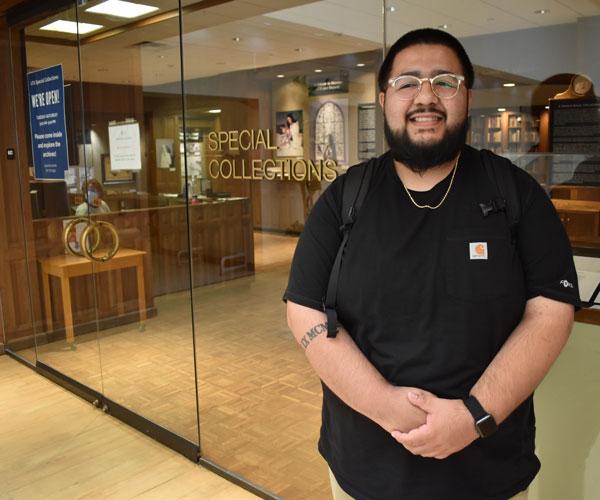
by Library News


by Library News
Over the summer, Sampson Dewey had the unique opportunity to help honor Native American tribes through his internship with the Dallas Museum of Art and UTA Libraries Special Collections Department.
As a member of the Fallon Paiute-Shoshone Tribe of Fallon, Nevada, Sampson provided unique insight while reviewing historical documents for the university and the histories of tribal lands as a land acknowledgment task force member for the museum.
A land acknowledgment is a formal statement that shows respect and honors the land's Indigenous people. The acknowledgment seeks to provide a complete history of the area and not exclude Indigenous peoples' contributions.
Before Sampson served on the DMA's task force, he helped with UTA's land acknowledgment statement as a student. He felt honored to serve in this role, representing and giving a voice to Native Americans from the past and present.
At the Dallas Museum of Art, Sampson researched, reviewed, and updated information on current land acknowledgments with other groups. He developed a contact list of Native American Representatives and allies who could help the task force in their next steps in the land acknowledgment process.
Through Sampson and fellow task force members' efforts, the DMA's acknowledgment recognizes that its location was the ancestral home of the Caddo, Wichita, Tawakoni and Kiikaapoi, as well as other peoples that passed through the area, including the Comanche, Kiowa, the Apache and other unknown Indigenous peoples.
Work at UTA
The other half of Sampson's internship was in the UTA Libraries' Special Collections Department, reviewing historical documents from or related to Native Americans. During his work, Sampson reviewed items in the collection to see if any historical inaccuracies and culturally sensitive information, such as descriptions of prayers and ceremonies, were present and see if they might need to be restricted.
One of the items that made an impression on Sampson was a Western Navajo Indian School journal from 1909 from Tuba City, Arizona. Sampson had to transcribe and research the journal. In the journal, students would write about their lives.
"The teachers had them do a monthly journal. Students would copy different articles on stories they were reading and share them with people in the community," Sampson said. "One of the (entries) that I remember is that they were talking about how their teacher told them how to grow corn. So, the teacher told them to bring in a box. He filled it with soil and grew some corn. He (the student) drew a little picture of the presentation in the journal."
Sampson stated that he dove deeper into finding out more about these students by looking at documents such as the Indian census of 1910. The census gave biographical information on these students, such as their occupation after leaving school and the names of their family members.
With his internship completed, Sampson plans to continue working with UTA and the DMA land acknowledgment projects. He also wanted to let people know that there is an Indigenous Peoples Day Celebration taking place from 3-7 p.m. Monday, Oct. 10, and encourages everyone to come out.
To find out more about the Indigenous Peoples Day Celebration, go to https://bit.ly/3BIghBM for more information.
Add new comment